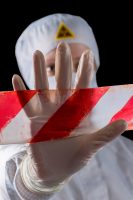
The Edgewood Chemical Biological Center (ECBC), the Defense Threat Reduction Agency, the U.S. Army Natick Soldier Research, Development and Engineering Center, and North Carolina State University recently teamed up to develop a uniform that destroys chemical agents on contact using a type of molecule called metal-organic frameworks (MOFs).
MOFs are defined as nano-constructed materials constructed of organic struts consisting of oxygen, hydrogen and carbon, and metals such as zinc or zirconium. One development under consideration, called UiO-66-NH2, is very stable in air, acids and solvents, and can also pull water from the atmosphere, which helps its ability to destroy potential contaminants. The material can also expand in size, which allows for faster contaminant destruction.
“One of the potential results of this research is replacing the current Joint Services Lightweight Integrated Suit Technology, called JSLIST, with an extra layer of protection in the combat uniform Soldiers already wear every day,” Greg Peterson, ECBC research chemical engineer and leader of the research team, said. “The JSLIST is hard to put on, and when a gas mask is added, combat performance is reduced. We will replace it with a better uniform and a balaclava they can pull over the face plus gloves to achieve the same level of protection.”
ECBC is a U.S. Army Research, Development and Engineering Command laboratory and is the Army’s principal research center for chemical and biological defense technology, engineering and field operations.




